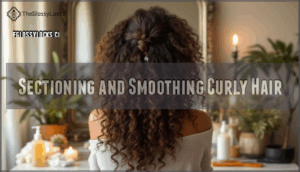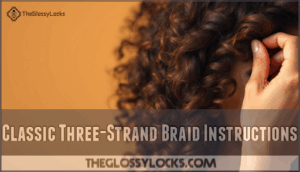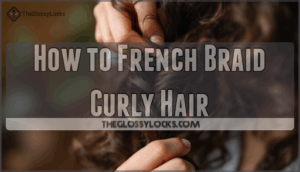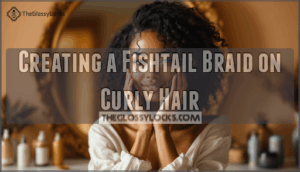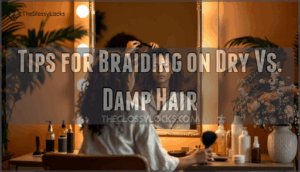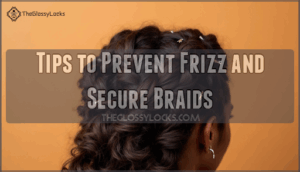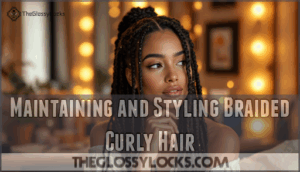This site is supported by our readers. We may earn a commission, at no cost to you, if you purchase through links.
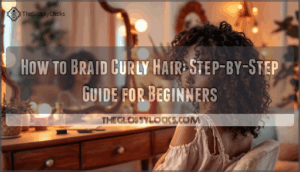 Your curls have a mind of their own, and trying to wrangle them into a braid can feel like negotiating with a tornado. The tight coils spring back, the frizz multiplies with every pass of the comb, and halfway through, you’re left wondering if braiding curly hair is even possible without a professional degree.
Your curls have a mind of their own, and trying to wrangle them into a braid can feel like negotiating with a tornado. The tight coils spring back, the frizz multiplies with every pass of the comb, and halfway through, you’re left wondering if braiding curly hair is even possible without a professional degree.
Here’s the truth: curly hair doesn’t need to be tamed into submission—it needs the right approach. When you work with your texture instead of against it, those spirals transform from obstacles into assets that create braids with dimension and personality most straight-haired tutorials never mention. The secret lies in preparation, technique, and understanding what makes curly hair different.
Table Of Contents
- Key Takeaways
- How to Prepare Curly Hair for Braiding
- Sectioning and Smoothing Curly Hair
- Step-by-Step Braiding Techniques for Curly Hair
- Tips to Prevent Frizz and Secure Braids
- Maintaining and Styling Braided Curly Hair
- Frequently Asked Questions (FAQs)
- How long should I leave my braids in for best results?
- What products should I use to braid my curly hair?
- How often should I braid my hair?
- Do I need to blow dry my hair before braiding?
- Is braiding curly hair difficult?
- How often should I wash curly hair between braids?
- Can I braid hair extensions into curly hair?
- How long can I keep braids in curly hair?
- Will braiding damage my curl pattern permanently?
- Conclusion
Key Takeaways
- Curly hair braids best when you work with the natural texture rather than forcing it straight, using moisture-rich products like leave-in conditioner and oils to prep and protect your curls before you start weaving.
- Detangle on damp hair with fingers first, then a wide-tooth comb, working in small sections from ends to roots to minimize frizz and breakage before sectioning for your braid.
- Braiding damp curls creates smoother, longer-lasting styles with better grip, while dry braiding gives you fuller volume and a lived-in texture—experiment with both to find what works for your goals.
- Keep braids in for three to seven days maximum, secure ends with snag-free elastics and bobby pins, and sleep with a satin pillowcase or silk scarf to reduce friction and maintain your style without damage.
How to Prepare Curly Hair for Braiding
Getting your curls ready for braiding isn’t about forcing them into submission—it’s about working with what you’ve got. The right prep makes all the difference between a braid that holds and one that falls apart by lunch.
Here’s what you need to focus on before you start braiding.
Choosing The Right Hair Products
Your hair products make or break your braid. Start with sulfate-free shampoos and conditioners that maintain moisture balance without stripping natural oils.
Look for styling products with hydrating ingredients like shea butter or argan oil—these work wonders on your texture. Check product reviews from other curly-haired people before buying.
Natural hair products often give you the best results for curly hair care, keeping your strands smooth and ready for weaving. Understanding your hair porosity levels is essential for selecting the right products.
Detangling Without Causing Frizz
Once you’ve got the right products lined up, your next battle is detangling without turning your curls into a frizzy mess. Here’s your game plan for curl preservation:
- Start on damp hair—never bone dry—to minimize frizz control issues
- Apply hair serum or leave-in conditioner liberally before touching a single strand
- Use your fingers first to gently work through major knots
- Switch to a wide-tooth comb for gentle combing from ends to roots
- Work in small sections to maintain control while detangling curly hair
This approach keeps your hair care routine damage-free and sets you up perfectly for braiding techniques that actually last.
Moisturizing and Protecting Your Curls
After detangling, your curls need a moisture barrier—think of it as armor against frizz and breakage during the braiding process. Layer hydrating products strategically to lock in moisture balance and boost curl definition.
| Product Type | Purpose | Application Timing |
|---|---|---|
| Hair Mask | Deep conditioning for hair health and wellness | 1-2x weekly before washing |
| Leave-in Conditioner | Maintains moisture balance and frizz control | On damp hair post-wash |
| Hair Oil | Seals cuticle for hair oil benefits and texture enhancement | Final step on slightly damp curls |
| Curl Cream | Defines curl pattern while hydrating | Mid-application on damp sections |
| Light Serum | Smooths flyaways without weighing down curly hair | Sparingly on dry areas pre-braid |
This curly hair care foundation guarantees your hair texture and style stay protected throughout the braiding journey.
Tools Needed for Braiding Curly Hair
With your curls now prepped and protected, you’ll need the right arsenal of tools to turn that moisture-locked hair into a braid that actually holds.
Grab a wide-tooth comb or braid brush for final smoothing, sectioning hair clips to divide your mane, and snag-free hair elastics or hair ties for securing ends.
Bobby pins are your backup—they’ll tame flyaways and anchor loose sections when braiding curly hair gets rebellious.
Sectioning and Smoothing Curly Hair
Once your curls are prepped and ready, the next step is all about control—dividing your hair into manageable sections and smoothing each one for a clean, polished braid.
The right technique here makes all the difference between a sleek finish and a frizzy mess. Let’s break down the best ways to section, smooth, and detangle without losing your curl pattern.
Effective Sectioning Techniques for Curls
Sectioning curly hair isn’t about fighting the texture—it’s about working with your curls to create clean, manageable parts that make braiding a breeze instead of a battle. Start by mapping out your hair zones, then use clips to hold sections while you work through each area systematically.
- Use your fingers for initial curl clumping before applying sectioning tools
- Divide hair into quadrants or triangular sections based on your braid style
- Work with your natural curl pattern instead of forcing straight parts
- Keep sections taut but not stretched to maintain texture integrity
- Release only one section at a time to prevent tangling between zones
Using Leave-in Conditioner or Hair Serum
Leave-in conditioner or hair serum is your secret weapon for transforming wild, unruly curls into braid-ready smoothness without stripping away the moisture your hair desperately needs.
Apply product to damp hair in small sections, raking it through from roots to ends. This technique boosts curl enhancement while providing slip that makes hair styling techniques infinitely easier.
The serum benefits include frizz control and shine—essential for clean, polished braids that last.
Wide-Tooth Combs Vs. Fingers for Detangling
Your fingers are the supreme Gentle Detangling tool—they give you tactile control to feel knots and work through them without hair breakage.
Wide-tooth combs excel at Tangle Removal on damp, conditioned curly hair, gliding through with minimal disruption to your curl preservation.
For best results when braiding curly hair, use fingers first to tackle major tangles, then follow with a comb for thorough detangling before weaving—this combo maximizes your Hair Styling Techniques while keeping your curls intact for impeccable braiding.
Using a wide tooth comb is essential for gentle detangling and preserving natural curl patterns.
Step-by-Step Braiding Techniques for Curly Hair
Now that your curls are prepped and sectioned, it’s time to master the actual braiding. Whether you’re going for a simple three-strand or something more intricate, the technique matters just as much as the prep work.
Here’s how to create each style step-by-step, plus when to braid on damp versus dry hair.
Classic Three-Strand Braid Instructions
The three-strand braid is your foundation—master this classic technique, and every other braid becomes infinitely easier to conquer. Here’s how to braid curly hair with confidence:
- Divide hair into three equal sections at the nape—balanced strand management prevents lopsided braid patterns.
- Cross the right section over the middle, weaving with steady hands and consistent braid tension.
- Cross the left section over the new middle, repeating this rhythm until you’re braiding like a pro.
- Secure with a hair elastic two inches from the ends—these finishing touches matter for hair texture like yours.
- Gently tug each loop to create dimension and own your braiding and styling mastery.
How to French Braid Curly Hair
French braiding curly hair isn’t harder—it’s actually your secret weapon for keeping those spirals sleek and controlled all day long.
Start with three sections at your crown, then grab small pieces as you weave—this technique works brilliantly across all curly hair types and braid patterns.
The key? Keep tension firm but gentle to respect your hair texture while mastering these French braid tips with your curly styling tools.
Creating a Fishtail Braid on Curly Hair
A fishtail braid on curls might look intricate, but it’s actually more forgiving than a French braid—those textured spirals hide imperfections beautifully while creating serious visual impact.
Split your hair into two equal sections instead of three, then pull thin strands from each outer edge and cross them over. This weaving pattern works magic on curly hair textures because it grips naturally—no slipping.
Keep your hair strand management consistent, and you’ll master these fishtail braid tips fast.
Tips for Braiding on Dry Vs. Damp Hair
Your hair’s moisture level when you start braiding makes all the difference—damp curls are easier to manipulate and hold their shape better, while dry hair gives you more volume and a lived-in finish.
Here’s what you need to know about each approach:
- Damp braiding maximizes curl definition and frizz control while locking in moisture levels for smoother hair texture
- Dry braiding delivers braid longevity with fuller body and natural movement throughout your style
- Apply styling products to damp hair for better grip when braiding curly hair that’s prone to slip
- Dry hair styling works best when you want textured, boho vibes without tight control
- Experiment with both braiding techniques to discover what suits your curly hair goals
Tips to Prevent Frizz and Secure Braids
You’ve nailed the braiding technique, but keeping those curls frizz-free and locked in place takes a few smart moves.
The right products and tools make all the difference between a braid that falls apart by lunchtime and one that stays put all day.
Here’s how to keep your curly braid smooth, secure, and totally under your control.
Using Hair Masks and Light Hold Products
With hair masks and light hold products in your arsenal, you’re stepping into the world of frizz-free, long-lasting braids. Hair masks quench dehydrated curls before you braid, softening strands for smoother weaving. Product layering comes next—apply a leave-in conditioner, then a light hold hairspray to set your style without weighing hair down. This combination gives you hold level control while enhancing your curly hair’s natural texture and reducing frizz throughout the braiding process.
| Product Type | Primary Benefit | When to Apply |
|---|---|---|
| Hair Mask | Deep moisturizing, frizz reduction | Before braiding (15-30 min) |
| Leave-in Conditioner | Detangling, styling enhancement | On damp hair |
| Light Hold Hairspray | Hold level control, flyaway taming | After braiding complete |
| Hair Serum | Smoothing, shine boost | Mid-braid or finishing touch |
Best Methods to Secure Braid Ends
Once your braid is woven tight and looking sharp, the last thing you want is for it to unravel before you’ve even walked out the door. Here’s how to lock it down:
- Elastic bands are your go-to for braid finishing—wrap twice for hold, three times if your hair’s thick
- Bobby pins tucked underneath secure loose ends without showing
- Hair ties with metal clasps grip better than basic elastics and won’t snap mid-day
Choose hair accessories that match your curl texture for secure wraps that actually last.
Preventing Flyaways and Fraying
Even with your ends locked down tight, stray hairs have a way of staging a rebellion by midday—especially when humidity’s in the mix.
Combat flyaway taming with a light edge-laying gel or anti-frizz serum smoothed along the braid’s surface. A boar bristle brush works wonders for hair smoothing without disrupting your weaving.
Finish with a flexible-hold hairspray to seal your braid finish while keeping curly hair care intact—no crunchy texture, just controlled flyaways.
Tools and Accessories for Long-Lasting Braids
The right gear transforms a decent braid into one that survives spin class, surprise rainstorms, and whatever else your day throws at it.
Stock your toolkit with these essentials:
- Snag-free hair ties and hair elastic bands that grip without snapping
- Bobby pins for anchoring loose sections mid-braid
- Edge control gel to tame baby hairs along your hairline
- Hair slides or decorative hair accessories for braids that double as reinforcement
These styling tools and braiding techniques work together—no braid extensions needed unless you’re chasing extra length.
Maintaining and Styling Braided Curly Hair
Once you’ve nailed the braid, the real game begins—keeping it fresh, frizz-free, and full of life. A few smart moves throughout the day (and night) will help your style hold its shape without falling flat.
Here’s how to maintain, refresh, and safely unravel your braided curls when you’re ready for a change.
Checking and Touching Up Your Braid
Nothing kills your confidence faster than spotting a loose strand or frizzy halo mid-day when you thought your braid was locked in tight. Keep bobby pins stashed in your bag for quick braid maintenance—slide them in to tame flyaways without unraveling your whole style.
A light mist of water or leave-in conditioner brings instant braid revival, smoothing frizz while preserving your curly hair’s texture and keeping those braiding techniques intact all day.
Sleeping With Braids to Reduce Frizz
For overnight care that guards your curls against friction, loose braids work like armor—reducing frizz by over 40% while you sleep. Braid placement matters: central braids down your back beat pigtails for comfort and frizz reduction.
Keep braid tightness gentle to protect hair health and prevent breakage, then swap your pillowcase for satin to lock in moisture. Toss a silk scarf over your braids for advanced hair maintenance, and you’ll wake up with curly hair that’s ready to slay.
Adding Volume and Texture to Braids
Want to transform a sleek braid into something that screams personality and dimension? Gently tug outward on alternating sections to boost braid thickness and create that coveted undone vibe.
This hair puffing technique delivers an instant volume boost while enhancing curl definition—think editorial texture without the salon price tag.
For maximum texture enhancement, focus your pulling on the outer edges, letting your curly hair style breathe with rebellious, lived-in charm.
Safely Removing Braids to Prevent Damage
Rushing through braid removal is like yanking a zipper that’s caught—you’ll leave a mess of broken strands and regret in your wake. Start at the elastic and work upward, using your fingers for gentle unraveling while applying detangling spray.
This braid aftercare method prevents hair damage and keeps frizz control intact, protecting your curls during hair maintenance without sacrificing the weaving work you’ve done.
Frequently Asked Questions (FAQs)
How long should I leave my braids in for best results?
Studies show protective styles can accelerate hair growth by 30% when properly maintained.
For curly hair, keep braids in three to seven days maximum—this protects your scalp health and prevents tension damage while maintaining style longevity and ideal braid maintenance throughout the weaving process.
What products should I use to braid my curly hair?
Start with sulfate-free shampoos and leave-in products to build your foundation. Layer on curl creams for definition, then lock everything down with hair oils and frizz fighters.
These styling products for curly hair give you control when braiding curly hair—your complete hair care guide starts here.
How often should I braid my hair?
You wouldn’t skip leg day at the gym, right? So don’t overdo braiding either. Aim for 2-3 times weekly to balance curl definition with hair growth—frequent braiding offers styling variety without stressing your strands, keeping braid durability and overall hair care in check.
Do I need to blow dry my hair before braiding?
You don’t need to blow dry curly hair before braiding. Air drying or damp styling works best for frizz control and braid prep, especially with your hair porosity in mind—just avoid soaking wet strands.
Is braiding curly hair difficult?
Braiding curly hair isn’t difficult—it just requires a different approach than braiding straight hair.
With proper detangling tools and the right technique for your hair texture, you’ll master braids quickly, whether tackling a French braid or simple weaving styles.
How often should I wash curly hair between braids?
Your washing frequency depends on hair porosity and scalp care needs—usually every 5-7 days works for most curly hair types in braids.
Focus on curl refresh between washes and maintain braid hygiene to support overall hair health.
Can I braid hair extensions into curly hair?
Yes, you can braid hair extensions into curly hair, but success depends on Extension Types and achieving a Curly Match.
Choose extensions that blend with your natural texture to avoid Braid Damage and maintain a smooth Hair Blend.
How long can I keep braids in curly hair?
You can keep braids in curly hair for one to three days. Braid longevity depends on hair texture, curl patterns, and braid maintenance.
Style durability improves with proper hair care techniques, but remove braids before washing to protect your curls.
Will braiding damage my curl pattern permanently?
Like water finding its natural course, your curl pattern won’t suffer permanent damage from braiding. Proper braid tension, frizz control, and damage prevention techniques protect hair texture and curl definition.
Tight braiding hair repeatedly can temporarily stretch curls, but gentle weaving preserves your natural curly hair structure beautifully.
Conclusion
Rome wasn’t built in a day, and your first braid mightn’t be picture-perfect—but that’s the beauty of working with texture.
Each time you section, smooth, and weave, you’re training your hands to respect the curl pattern rather than fight it. Learning how to braid curly hair isn’t about forcing order; it’s about discovering rhythm.
With the right prep, technique, and a little patience, those spirals will fall into place exactly as they should—wild, dimensional, and undeniably yours.
- https://www.tiktok.com/
- https://odelebeauty.com/blogs/the-rinse/finger-detangling-benefits
- https://bglh-marketplace.com/2025/07/combing-vs-finger-detangling-which-is-better/
- https://www.reddit.com/r/Naturalhair/comments/1ds8f38/unpopular_opinion_the_greatest_culprit_in_hair/
- https://fullondon.com/blogs/news/why-wide-tooth-combs-are-great-for-curly-hair

